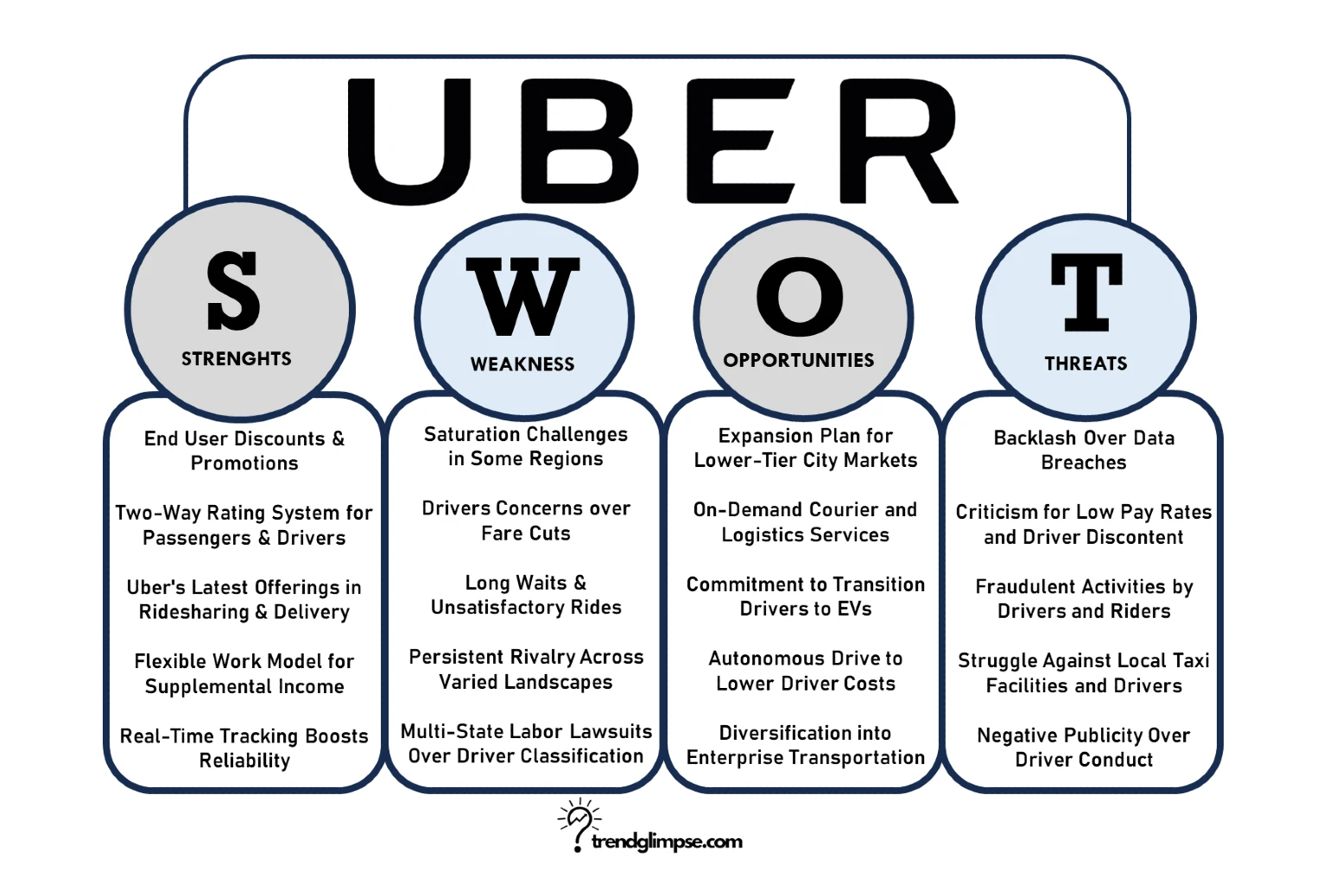An Overview of Uber
Uber is the pioneering ride-hailing app that has disrupted the taxi industry since its launch in 2009. Over the past decade, Uber has experienced meteoric growth by offering convenient, on-demand transportation through its easy-to-use platform connecting riders and drivers.
Headquarters: San Francisco, California, United States
Industry: Transportation & Mobility
Current CEO: Dara Khosrowshahi
Annual Revenue [2023]: US$ 31.87 Billion
Employee Count: ~32,800
Website: Uber.com
Uber has provided over 10 billion rides worldwide since launching just 15 years ago. Over 4 million drivers have worked for Uber, highlighting the scale of economic opportunities created. UberEATS has grown dramatically, with over 825,000 restaurants in 500+ cities on the delivery platform.
Ride-sharing, Uber Eats, Freight & Package Delivery, Uber for Business, Rewards, Rent, Health, Autonomous Vehicles
Brand Portfolio of Uber
Uber Eats, Car Next Door, Cornershop, Drizly, Postmates, Careem (2020-2023)
Competitiors of Uber
Lyft, Didi Chuxing, Ola, Grab, Curb, Via, Juno, Gett, Careem, Bolt, Yandex.Taxi, Easy Taxi, Gojek, BlaBlaCar, DiDi Express, Cabify, Mytaxi
Let’s take a look at Uber using a SWOT Analysis framework to assess its current situation and potential moving forward. An Uber SWOT Analysis involves analyzing Uber’s strengths, weaknesses, opportunities and threats as one of the preeminent ridesharing platforms globally.

Strengths of Uber
Targeted End User Discounts and Promotions
By leveraging the data they collect on customer behavior and preferences, Uber can offer specially tailored deals to riders. This could be a discount on their next 3 rides, a promo code for free delivery from Uber Eats, or bonus credits for referring friends.
The tailored promotions also allow Uber to attract new demographics of users who may be swayed by the right offer at the right time. For Instance, During the COVID 2019 pandemic, Uber Netherlands announced 25% discount along with 10,000 free trips to healthcare workers through the UberMedics program.
Two-Way Rating System for Passengers and Drivers
After each ride, drivers and passengers can rate each other from 1 to 5 stars. This provides useful feedback on the quality and behavior of both drivers and riders. For drivers, it incentivizes great customer service and safe driving. For passengers, it discourages rude or inappropriate behavior. Drivers with low ratings can be suspended from the platform.
Uber’s Latest Offerings in Ridesharing and Delivery
Uber has leveraged their expertise in mobility and logistics to launch services like Uber Eats for food delivery, Uber Freight for long-haul trucking, Uber Works for staffing, and more. This diversification makes smart use of Uber’s vast network of drivers, advanced dispatch technology, and user base. It also hedges against any declines in their core ridesharing segment.
Anticipating a 250% rise in U.S. visits to Europe in summer 2023, Uber is enhanced its offerings and coverage in various cities and airports. Uber Travel, available in over 10,000 cities, facilitates trip planning by consolidating flight details and suggesting rides to and from transportation hubs.
Uber’s Trusted Partnerships
An important strength of Uber is the partnerships they’ve cultivated with key stakeholders. Uber has deals with major car rental agencies to get discounted vehicles for drivers. They also partner with insurance companies to develop coverage options for drivers. They also give Uber insight into different industries to shape win-win transportation solutions.
For Instance, In April 2023, Uber Eats partnered with Little Caesars. While on September 2023, Uber partnered with EVSE to provide convenience of at-home charging to its consumers. Moreover, Uber has partnered with Arizona State University to offer 100% tuition coverage for eligible drivers who have completed at least 3,000 lifetime trips and have Gold, Platinum, or Diamond status through Uber Pro.
Global Footprint as the Face of On-Demand Travel
A major strength of Uber is their massive global presence. They operate in over 70 countries and 10,000 cities worldwide. This huge footprint makes Uber synonymous with on-demand ridesharing for millions globally. Their scale and brand power reinforces consumer habits to “Uber” places as a verb.
Being established worldwide also provides operational efficiencies – drivers can easily relocate between cities, and riders feel comfortable using Uber anywhere. As personal transportation evolves, Uber’s global reach positions them to lead the way.
Flexible Work Model for Supplemental Income
Uber allows people to drive on their own schedule, acting as independent contractors. This provides a supplemental income source without strict hourly commitments. People can drive when convenient based on their availability and needs.
Retirees, students, and those seeking part-time work are able to earn extra money without major lifestyle changes. The model creates income diversification, expanded purchasing power, and financial stability for participants. With such flexibility, Uber can onboard drivers quickly and provide capacity to meet rider demand.
Real-Time Tracking Boosts Reliability
Riders can watch their driver approach dynamically on a map, with estimated arrival times. This transparency reduces uncertainty around pickup logistics. Drivers also have access to optimal routing and ETAs to provide accurate estimates. If delays occur, riders are updated accordingly. The tracking and ETAs combined foster trust and punctuality. Issues can be proactively communicated, preventing frustration. By monitoring movements in real-time, Uber can also ensure safety for both drivers and riders.
Weakness of Uber
Uber Faces Saturation Challenges in Some Regions
Uber has experienced rapid growth and market penetration in many cities around the world. However, there are signs that demand for Uber rides is leveling off in some of their most established markets. For example, in New York City, Uber trip growth slowed to just 2% in 2019 after years of double digit growth.
This indicates the market is becoming saturated with riders who already use the service regularly. Uber may struggle to continue growing ridership in these mature markets. To find new growth, Uber will need to expand into new geographic regions and segments of riders not currently using the service.
Micromobility and Public Transit Challenge Uber
The rise of micromobility services like bike and scooter sharing could pose a threat to Uber. These options provide inexpensive, short distance transportation similar to UberX rides. Services like Lime and Bird are expanding rapidly, especially in urban centers which are Uber’s strongholds.
Public transit also presents increasing competition. Cities are investing in transit infrastructure and ridership is growing. Uber has attempted to enter micromobility itself via acquisition of Jump bikes, but faces stiff competition from dedicated providers.
Long Waits and Unsatisfactory Rides
Uber continues to face challenges providing uniformly speedy and high-quality service, due to reliance on independent contractors. Customers sometimes complain of late pickups or long trips due to inefficient routing. This results in frustrated customers and lower satisfaction.
Supply and demand imbalances can leave riders waiting extended periods during busy times. Meanwhile, some drivers strategically reject or cancel trips to optimize for profitability over promptness. Uber’s decentralized model makes it difficult to coordinate supply and demand to minimize wait times. Uber has made a number of improvements that have enhanced the ride experience, though there are still opportunities to further streamline and perfect the service for quick, seamless rides.
Persistent Rivalry Across Varied Landscapes
Uber faces competition from strong rivals in nearly every geographic market and segment they operate in. Competitors like Lyft directly mimic their ridesharing model, while others like Ola and Didi Chuxing have claimed dominance in India and China respectively.
Regionally focused players undermine Uber’s growth opportunities and profit margins in those markets. With little proprietary technology or barriers to entry, Uber struggles to ward off competition everywhere it goes. Rivals with local expertise or singular focus on a specific service type consistently challenge Uber.
Multi-State Labor Lawsuits Over Driver Classification
Uber faces ongoing lawsuits in multiple states alleging improper classification of drivers as independent contractors rather than employees. States like California, Massachusetts and New Jersey argue this deprives drivers of entitled benefits and protections like minimum wage, overtime pay, workers compensation, unemployment insurance and the right to unionize.
The lawsuits claim Uber exhibits significant control over drivers through behavioral standards, performance metrics, fares and other policies – qualifying them as employees under state laws. Uber maintains drivers value the independence and flexibility afforded by contractor status. However, if forced to transition drivers to employees, Uber would face substantially higher costs and potential service disruptions.

Opportunities for Uber
Expansion Plan for Lower-Tier City Markets
As urbanization continues globally, millions are moving to second- and third-tier cities in search of more affordable housing and jobs. These cities often have inadequate public transit systems, opening a gap for Uber to provide convenient and cost-effective on-demand transportation.
By tailoring offerings to match local needs and preferences, educating new users, and recruiting driver-partners, Uber can gain first-mover advantage in these untapped markets. Success in smaller cities also provides supply-side density that enables expansion into adjoining rural and suburban communities.
On-Demand Courier and Logistics Services
Whether it’s food, groceries, or parcels, Uber’s algorithms and infrastructure can enable quick and reliable delivery. This allows them to meet growing consumer demand for same-day delivery while also providing their driver-partners with additional earning opportunities.
By integrating with various retailers, restaurants, and shippers, Uber can become the preferred platform for moving goods in cities. Their scale and experience managing peak demand would be a competitive advantage in the hypercompetitive same-day delivery space. However, success will depend on providing superior service and execution versus incumbent players like DoorDash and Instacart.
Commitment to Transition Drivers to EVs
By subsidizing or financing the purchase of EVs, providing charging infrastructure, and educating drivers on the benefits, Uber can incentivize adoption. This will reduce Uber’s overall carbon footprint and provide a competitive edge among eco-conscious riders. However, the higher upfront cost of EVs remains a barrier for many driver-partners.
Uber could partner with automakers to develop affordable EV options optimized for rideshare use. Transitioning to EVs will be a long-term undertaking, but Uber’s scale provides immense leverage to transform urban transportation electrification.
Autonomous Drive to Lower Driver Costs
Once the technology is proven safe and reliable at scale, Uber can roll out fleets of self-driving cars that can provide rides 24/7 without a driver. This would expand Uber’s service capacity and availability while dramatically lowering its operating costs.
For Instance, Uber is testing autonomous delivery with sidewalk robots and cars in several locations, including Fairfax, Virginia, Miami, Los Angeles, and Mountain View, California. It has formed partnerships with companies like Waymo, Aurora, Cartken, Motional, Nuro, and Serve Robotics for autonomous solutions.
Diversification into Enterprise Transportation Solutions
With its massive driver network and technology stack, Uber can cost-effectively provide commuting, shuttle and workforce transportation services. Industries like hospitality, retail, healthcare and construction can benefit from managed transportation versus owning private fleets.
Uber already offers Uber Central for business customers but can further customize by vertical, adding scheduling, reporting and billing features for enterprises. The B2B market has different needs and higher revenue potential versus Uber’s core consumer business. However, competing with incumbent vendors like Transdev requires developing enterprise-grade capabilities beyond Uber’s standard consumer offerings.
Collaboration in Healthcare for Hospital Discharges
Healthcare providers often struggle to arrange transit for discharged patients who are too frail to drive themselves home. Uber’s on-demand network can fill this gap, making sure patients make it home safely after being discharged. This would reduce readmissions and take a burden off care facilities.
Uber can tailor the experience by allowing hospitals to schedule rides on patients’ behalf, tracking each journey, and integrating payments. Healthcare partnerships also generate recurring revenue while providing a social good. However, Uber will need to address health privacy concerns and train drivers on interacting with recovering patients.
You Might Also Like – Starbucks SWOT Analysis
Threats for Uber
Backlash Over Data Breaches and Rider/Driver Info
Uber has faced significant backlash over multiple data breaches that exposed the personal information of millions of riders and drivers. In 2016, hackers stole the data of over 57 million Uber customers and drivers.
This raised concerns over Uber’s security practices and transparency. More recently in 2018, Uber revealed a separate hack that impacted 600,000 drivers. By proactively improving security protocols, Uber is demonstrating a commitment to learning from past mistakes and prioritizing customer and partner trust. Though work remains, their efforts illustrate how companies can evolve policies after missteps.
Negative Exposure to Fraudulent Activities by Drivers and Riders
While ridesharing platforms have enhanced transportation access, Uber recognizes ensuring customer and driver safety is an ongoing priority. Though the vast majority of rides are incident-free, a few high-profile cases have highlighted the need to continually reassess safety protocols. In response, Uber has rolled out a number of features aimed at improving transparency, accountability and peace of mind for all users. These include in-app emergency assistance, customizable driver screening criteria, two-way feedback systems and insurance protections.
By collaborating with lawmakers and community groups, Uber has an opportunity to lead the industry in proactive safety innovations. Their efforts to date, while not perfect, demonstrate a commitment to the wellbeing of both customers and driver-partners.
Struggle Against Local Taxi Facilities and Drivers
Taxi drivers protested Uber’s arrival in many cities, arguing it threatened their livelihood without adhering to the same licensing and regulations. Taxi groups lobbied lawmakers to block or ban Uber. In some markets, violence broke out between taxi drivers and Uber drivers. Taxi interests also filed lawsuits challenging the legality of Uber’s model. This opposition complicates Uber’s growth, raises compliance costs, and fuels negative publicity.
Negative Publicity Over Driver Conduct
Uber has faced scandals related to inappropriate or dangerous behavior by some of its drivers. Customers have reported issues like drunk driving, harassment, discrimination, and assault. While very rare, these incidents draw widespread media attention that can damage Uber’s brand reputation for safety.
The company is committed to customer wellbeing and has implemented rigorous protocols like background checks and ongoing feedback systems to uphold high service standards. While no platform is perfect, Uber continuously looks for ways to support responsible driving and enhance accountability through technology, partnerships and updated policies.
Conclusion
Looking at Uber’s SWOT analysis, their global footprint and widespread brand recognition position them strongly for future growth if they can overcome weaknesses like driver retention. Staying nimble, maximizing driver loyalty, and diversifying offerings will strengthen Uber’s leadership as outlined in this SWOT analysis. The road ahead still promises blue ocean growth potential.

I have always been fascinated by the inner workings of companies and industries. So I decided to study business to explore it more. My goal is to take all my research and turn it into cool stories that give people a better understanding of the business world.

